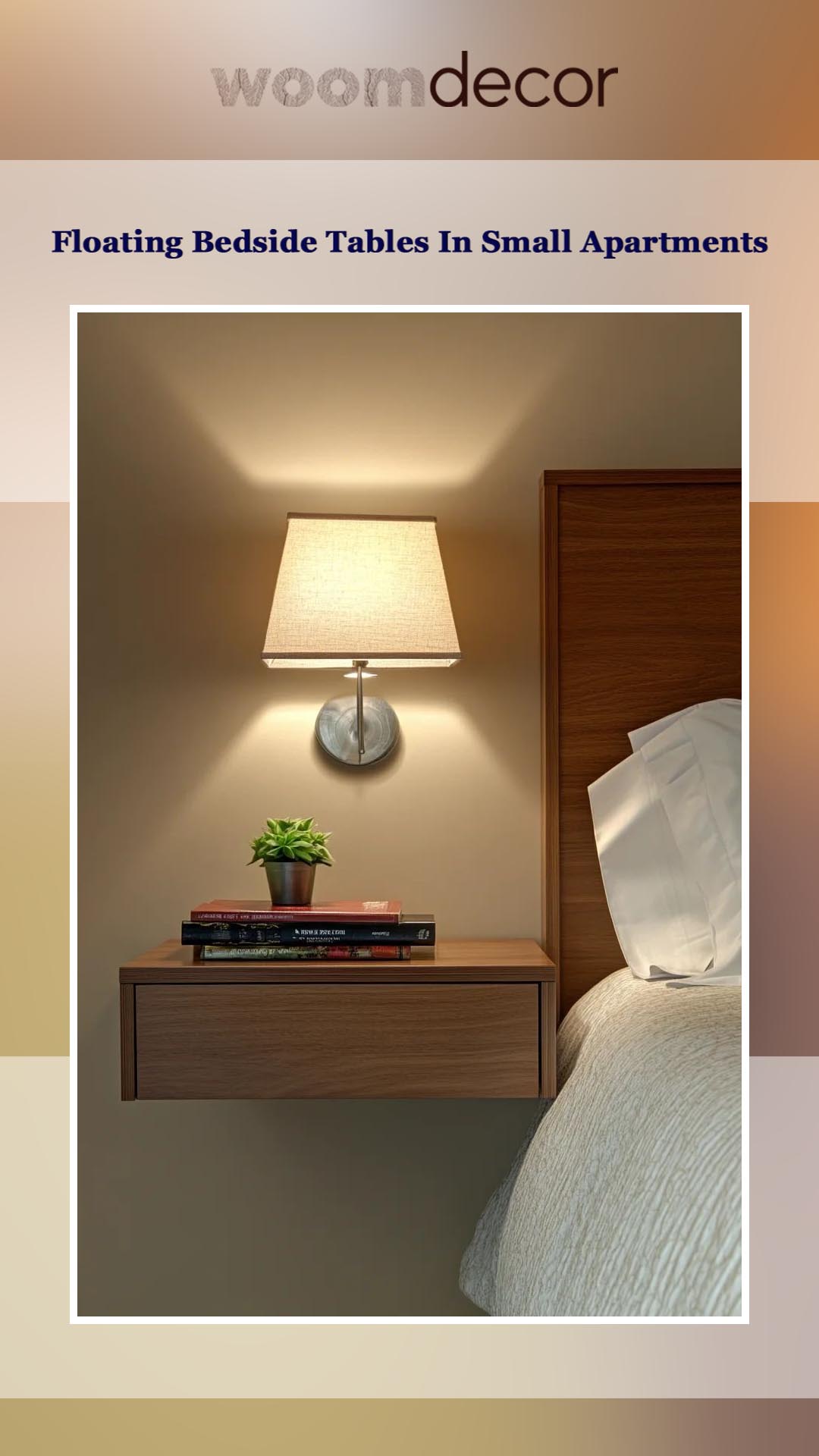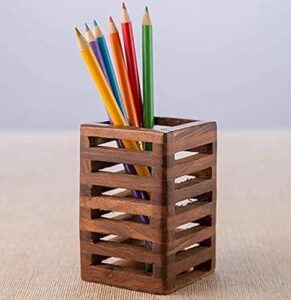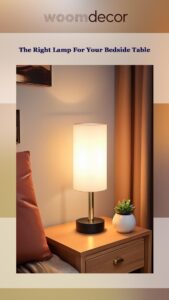Living in a small apartment can feel like a challenge, especially when it comes to maximizing space while maintaining style and functionality. One of the often-overlooked pieces of furniture in small apartments is the bedside table. Traditional bedside tables, with their bulky frames and need for floor space, can make a small bedroom feel even more cramped. Enter the floating bedside table—an innovative solution that combines practicality with sleek design. Floating bedside tables are wall-mounted units that “float” above the floor, leaving the space beneath open and free.
In this blog, we will explore the beauty and functionality of floating bedside tables in small apartments. We will discuss their advantages, design ideas, and installation tips, as well as how they can contribute to a more organized, spacious, and modern living environment.
1. The Importance of Maximizing Space in Small Apartments

Living in a small apartment means every inch of space counts. From minimizing clutter to choosing the right furniture, each decision must be made with efficiency in mind. Small apartments often require creative solutions to balance style, comfort, and functionality. Floating furniture pieces like bedside tables are an excellent example of how design can make a space feel larger, more open, and more functional.
Why Space Management Matters
Small apartments often lack the luxury of large rooms, making it vital to optimize space usage. Too much furniture can make a room feel cramped, while a lack of furniture can leave a space feeling empty and uninviting. Floating bedside tables offer an ideal solution—they free up valuable floor space and maintain the room’s visual appeal.
By choosing floating furniture, you can increase the sense of openness and make the room appear more airy. This also allows you to store more items in a minimalist way, which is a key feature in modern interior design. A floating bedside table can serve as a stylish storage solution without the bulkiness of a traditional one, giving you more floor area to move around and a cleaner look.
2. What is a Floating Bedside Tables?

Floating bedside tables are unique because they are mounted directly onto the wall, leaving the floor underneath unobstructed. They do not have traditional legs or support structures that touch the ground. Instead, they are installed with brackets or anchors, which hold them securely while creating a visually lighter effect in the room.
Design and Features of Floating Bedside Tables
- Wall-Mounted: As the name suggests, these tables are affixed to the wall and “float” above the floor.
- Space-Saving: The space beneath them is free, which allows for easier cleaning and a more open visual feel.
- Minimalistic Look: The design is often sleek and modern, with clean lines and no visible hardware or bulky elements.
- Variety of Styles: From minimalist to more decorative designs, floating tables can suit various interior styles, such as contemporary, Scandinavian, or industrial.
Floating bedside tables typically feature a single surface or a shelf, with or without drawers, providing a functional yet aesthetic piece for your bedroom. Some designs include open shelving, which is perfect for storing books or other small items. Others feature closed compartments for keeping your space neat and organized.
3. Advantages of Floating Bedside Tables in Small Apartments

Floating bedside tables offer a variety of benefits, particularly in small living spaces. Here are some of the key advantages:
3.1. Maximizing Floor Space
In a small bedroom, every bit of floor space is crucial. Traditional bedside tables often take up precious space that could be used for other furniture or movement. Floating bedside tables, on the other hand, leave the area below open, making the room feel more spacious and less cluttered. This extra floor area is especially important in small apartments, where maximizing available space is a top priority.
3.2. Easy to Clean
One of the major advantages of floating bedside tables is the ease of cleaning. Without legs or a bulky base, it’s simple to sweep or mop under the table. This is especially helpful in apartments where floor space is limited, and cleanliness is essential for maintaining a fresh, airy environment.
3.3. Sleek and Modern Design
Floating bedside tables are often associated with modern design aesthetics. Their clean lines and minimalist appearance make them a great fit for contemporary or minimalist bedroom themes. They bring a touch of sophistication and elegance to any room without overwhelming the space with excessive decor.
3.4. Customization Options
Floating tables can be customized to fit the specific needs of your space. Whether you need extra storage, a larger surface area, or a more compact design, floating tables come in a range of styles, materials, and sizes to suit different preferences. They can be designed to include drawers, shelves, or even built-in lighting for added functionality.
3.5. Visual Lightness
The fact that these tables don’t touch the floor gives them a visually lighter feel. This “floating” effect makes them less imposing, helping a small room feel less cluttered and more open. The absence of bulky legs allows the eye to focus on other elements in the room, which can be especially useful in tiny apartments.
4. Choosing the Right Floating Bedside Table for Your Small Apartment

When selecting a floating bedside table, there are several factors to consider. Here are some key points to help you choose the best option for your apartment:
4.1. Consider the Available Space
Before buying a floating bedside table, measure your available space to ensure that the table will fit comfortably. Remember to account for the space you need around the table for easy access. In smaller rooms, a compact floating table with minimalistic design will be more effective in creating an open, uncluttered look.
4.2. Material Selection
The material of the floating bedside table will significantly affect its look and durability. Wood, metal, and acrylic are popular options, each bringing its own aesthetic to the room:
- Wooden Floating Tables: These tables add warmth and natural beauty to the space. Wood complements a variety of interior styles, from rustic to modern.
- Metal Floating Tables: These tables often have a more industrial or contemporary vibe. They are durable and can come in various finishes, such as matte black, brass, or chrome.
- Acrylic Floating Tables: For a sleek, ultra-modern look, acrylic tables are a great option. They blend seamlessly into the decor, providing function without drawing attention.
4.3. Style and Design
There are a variety of styles to choose from, depending on your room’s design theme:
- Minimalist Design: Choose a simple, geometric shape with no extra embellishments if you prefer a clean and clutter-free aesthetic.
- Industrial or Modern: Floating bedside tables with metal frames or exposed hardware can add an industrial edge to your bedroom.
- Scandinavian or Mid-Century Modern: A wooden floating table with simple lines can bring warmth and charm to a Scandinavian-inspired space.
4.4. Storage Features
Think about the storage needs in your bedroom. Do you need drawers or open shelves for storing books, electronics, or other personal items? Some floating bedside tables come with built-in drawers or shelves, while others may have a more open design. Consider your specific needs and select a model that provides just the right amount of storage.
4.5. Colour and Finish
Choose a colour and finish that complements the overall colour palette of your bedroom. Neutral tones like white, black, or natural wood finishes work well in most rooms, but you can also select bold colours or unique finishes to create a statement piece.
5. How to Install a Floating Bedside Table

Installing a floating bedside table may seem intimidating at first, but it’s a relatively simple process if done correctly. Here’s a step-by-step guide to help you with the installation:
5.1. Tools You’ll Need
- Drill
- Level
- Measuring tape
- Screws and wall anchors
- Screwdriver
- Stud finder (optional, but helpful)
5.2. Find the Right Wall
Locate the wall where you plan to install the floating table. It’s important to ensure that the wall is sturdy enough to support the weight of the table. If possible, try to anchor the table to a wall stud for additional support. You can use a stud finder to locate the studs behind the drywall.
5.3. Measure the Height
Before drilling, measure and mark the exact height at which you want the table to sit. A common height for bedside tables is around 24 inches (61 cm) from the floor, but you can adjust this depending on your personal preference.
5.4. Install the Mounting Brackets
Most floating bedside tables come with mounting brackets that need to be attached to the wall. Drill pilot holes into the wall where you have marked your measurements, and then secure the brackets with screws and wall anchors if needed.
5.5. Mount the Table
Once the brackets are installed, carefully place the floating bedside table onto the brackets and secure it in place. Make sure it’s level before tightening the screws to ensure the table stays in position.
6. Design Ideas for Floating Bedside Tables in Small Apartments

The versatility of floating bedside tables allows you to get creative with their design. Here are some design ideas to inspire you:
- Compact with Clean Lines: Choose a small, simple floating table with just one shelf for a minimalist look.
- Integrated Lighting: Some floating tables come with built-in lighting underneath the surface, which adds ambiance to the room and helps save space.
- Floating Desk Combo: If space allows, opt for a floating bedside table that doubles as a mini workspace, featuring a surface large enough for a laptop or writing materials.
- Storage with Style: Look for tables that offer storage without sacrificing style. Drawers or open shelving can help you keep the space organized while maintaining a sleek appearance.
Q1. What are floating bedside tables and how are they different from regular bedside tables?
Answer:
Floating bedside tables are wall-mounted tables that appear to “float” without legs or a base touching the floor. Unlike regular bedside tables, which rest on the ground and often require floor space, floating bedside tables are attached directly to the wall at the desired height. This not only creates the illusion of more space but also allows for easier cleaning and a more modern, minimalist look.
The key difference lies in their structure and visual impact. While traditional bedside tables may add bulk to a room—especially in small apartments—floating ones eliminate visual clutter and contribute to a sleeker design. They also offer versatility in height adjustment and can be tailored to your specific layout, which is a significant advantage in compact living environments.
Q2. Are floating bedside tables strong enough to hold heavy items?
Answer:
Yes, floating bedside tables can be quite sturdy and capable of holding heavy items—provided they are properly installed. The strength depends primarily on two factors: the quality of the table’s construction and the method of wall mounting.
When mounted into wall studs (the wooden beams behind drywall), floating tables can support more weight—often up to 40-50 pounds or more. Using strong wall anchors or brackets designed for heavier loads will further increase stability. However, it’s always important to follow the manufacturer’s installation instructions and weight limits.
In most small apartments, floating bedside tables are used to hold essentials like a lamp, alarm clock, books, glasses, or a small plant. These items are typically well within the weight-bearing capacity of a well-installed floating table.
Q3. What are the benefits of using floating bedside tables in small apartments?
Answer:
Floating bedside tables offer numerous benefits for small apartments:
Space Optimization: Because they’re mounted on the wall, they free up valuable floor space, making the room feel larger and less crowded.
Easier Cleaning: With no legs or base on the ground, it’s easy to sweep or mop underneath them, maintaining cleanliness in tight spaces.
Modern Aesthetic: Their sleek, minimalist appearance enhances modern or contemporary interiors without overwhelming the room.
Customizable Height: Unlike fixed-height floor-standing tables, floating tables can be mounted at a height that perfectly suits your bed or usage needs.
Multifunctionality: Many floating bedside table come with built-in drawers or shelves, adding discreet storage without adding bulk.
Visual Lightness: Their “floating” nature makes them appear lighter, reducing the visual clutter that traditional furniture can create in a small room.
These benefits make floating bedside table a perfect blend of form and function, especially for compact living spaces.
Q4. How do I choose the right floating bedside table for my small bedroom?
Answer:
Choosing the right floating bedside table involves considering several key aspects:
Size and Proportion: Measure the space beside your bed and choose a table that complements the scale of your bed and room. Too large, and it’ll look overwhelming; too small, and it may not be functional.
Material and Style: Match the material (wood, metal, acrylic) and finish (natural, painted, stained) to your bedroom’s overall decor. For example, light wood tones pair well with Scandinavian styles, while matte black metal suits industrial or urban looks.
Storage Needs: Think about what you’ll use the table for. Do you need drawers for hidden storage? Or is a simple shelf sufficient? Your choice should reflect how you plan to use the space.
Color Coordination: Floating bedside tables come in a variety of colors. Choosing one that complements or contrasts tastefully with your bedroom palette will enhance the overall aesthetic.
Budget and Quality: Look for options that balance affordability and build quality. Even in small apartments, investing in durable, well-crafted furniture can save space and reduce the need for replacements.
Ultimately, the right floating bedside table should be a blend of functionality, durability, and design that aligns with your specific lifestyle and apartment layout.
Q5. How are floating bedside tables installed, and can I do it myself?
Answer:
Installing floating bedside tables is relatively straightforward and can often be done as a DIY project. However, precision is crucial to ensure the table is level, secure, and safe. Here’s a general guide to installation:
Choose the Wall: Pick a spot near your bed, ensuring the wall is strong enough to hold the table. If possible, mount into studs for maximum strength.
Measure and Mark: Use a tape measure and level to mark the desired height and ensure alignment.
Drill Holes: Pre-drill holes in the marked spots, using a stud finder to locate studs or wall anchors if studs aren’t available.
Install Brackets: Screw in the mounting brackets or wall anchors firmly.
Attach the Table: Secure the table onto the brackets, making sure everything is level and tight.
If you’re unfamiliar with tools or unsure about your wall’s condition (like drywall vs. brick), it might be wise to consult a handyman. In rental apartments, always check with the landlord before making permanent installations.
Q6. Are there floating bedside tables with drawers or storage compartments?
Answer:
Absolutely. Many floating bedside tables come with built-in drawers, cubbies, or shelves to provide functional storage while maintaining a minimalist aesthetic. These designs are especially useful in small apartments where extra storage is always in demand.
Here are some popular configurations:
Single Drawer Units: Provide a clean surface with hidden storage for personal items like medications, charging cables, or journals.
Double Drawer Designs: Offer increased storage without taking up additional space, often ideal for couples sharing a room.
Open Shelf + Drawer Combos: Great for displaying decorative pieces while keeping essentials tucked away.
Box-Style Shelves: A simple floating cube or rectangle design that’s open-fronted can serve both storage and display functions.
These combinations let you stay organized while keeping surfaces tidy, which is critical in small spaces where clutter can quickly build up.
Q7. How do I style a floating bedside table in a small bedroom?
Answer:
Styling a floating bedside table involves combining functionality with personal expression. Here are some ideas for small bedrooms:
Add a Wall Lamp: Instead of using table lamps, mount a sconce or reading light above the table to free up surface space.
Keep It Minimal: Limit items to essentials like a book, alarm clock, and maybe a small plant or candle to prevent clutter.
Use Vertical Space: Install a small shelf above the floating table for extra storage or display space.
Incorporate Art: Hang a small framed picture or artwork above the table for visual interest.
Match with Bedding: Coordinate colours and textures with your bed linens to create a cohesive look.
The key is to balance aesthetics with practicality. In small apartments, even minor decorative choices can have a big impact on the room’s overall vibe.











